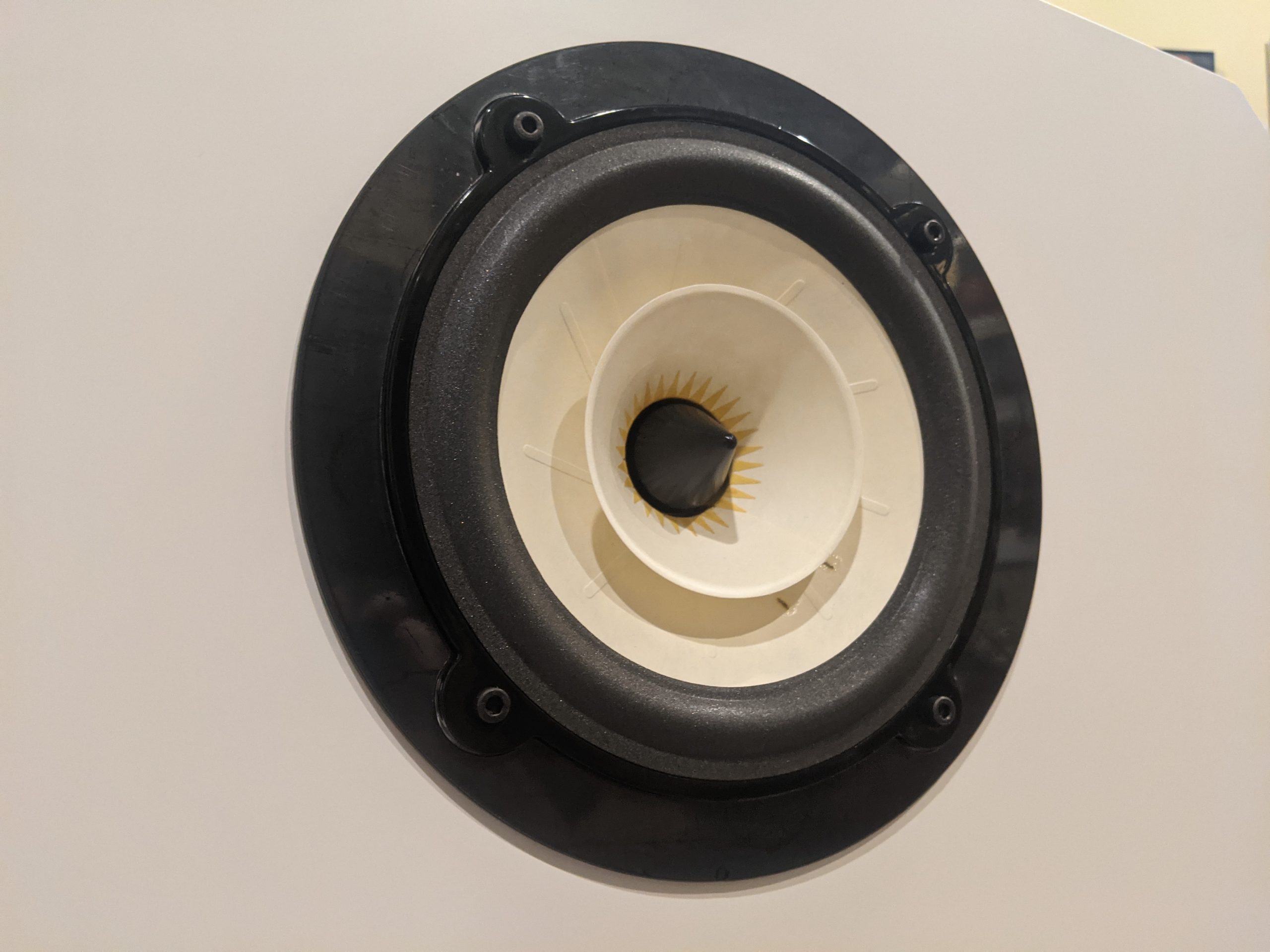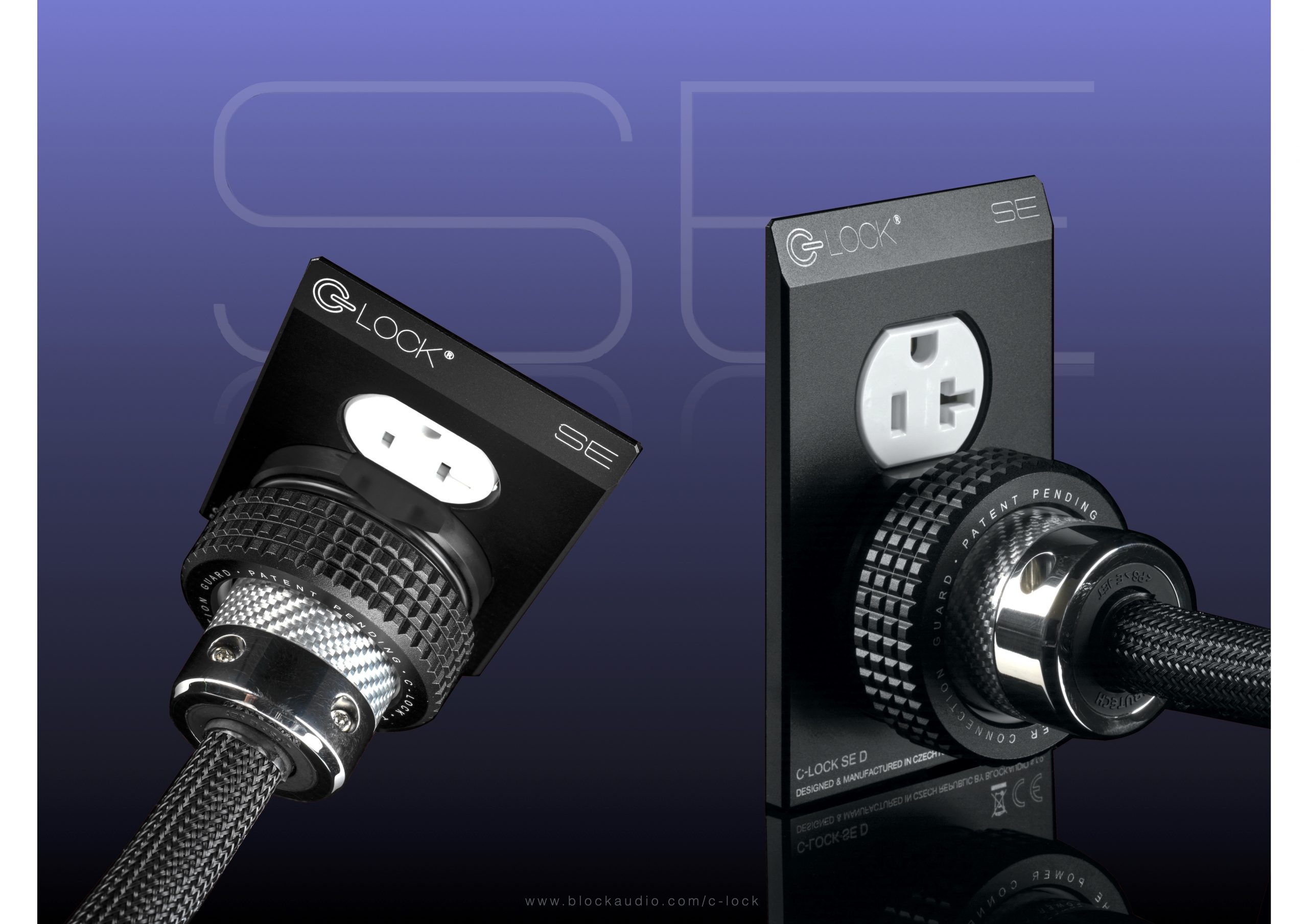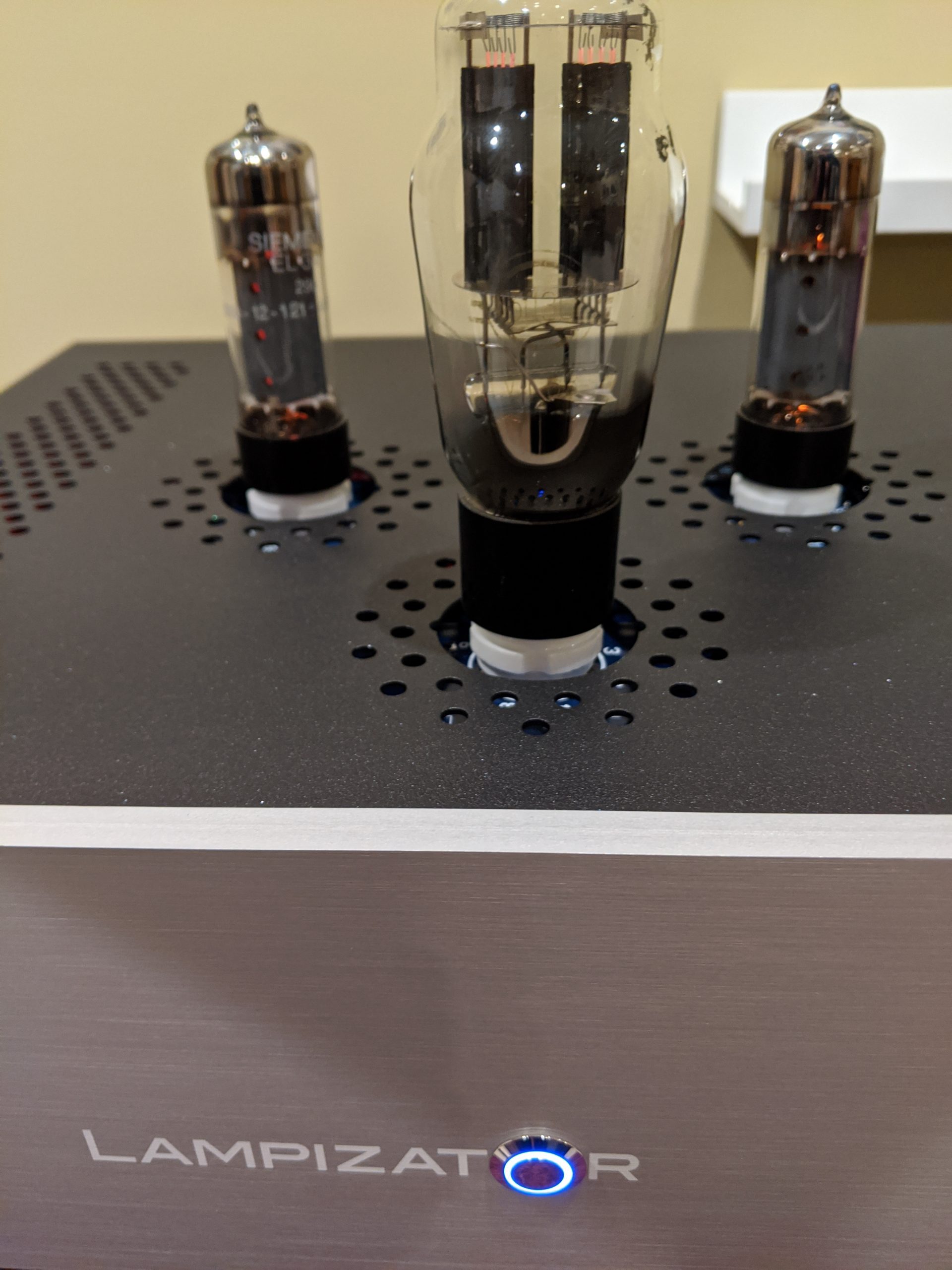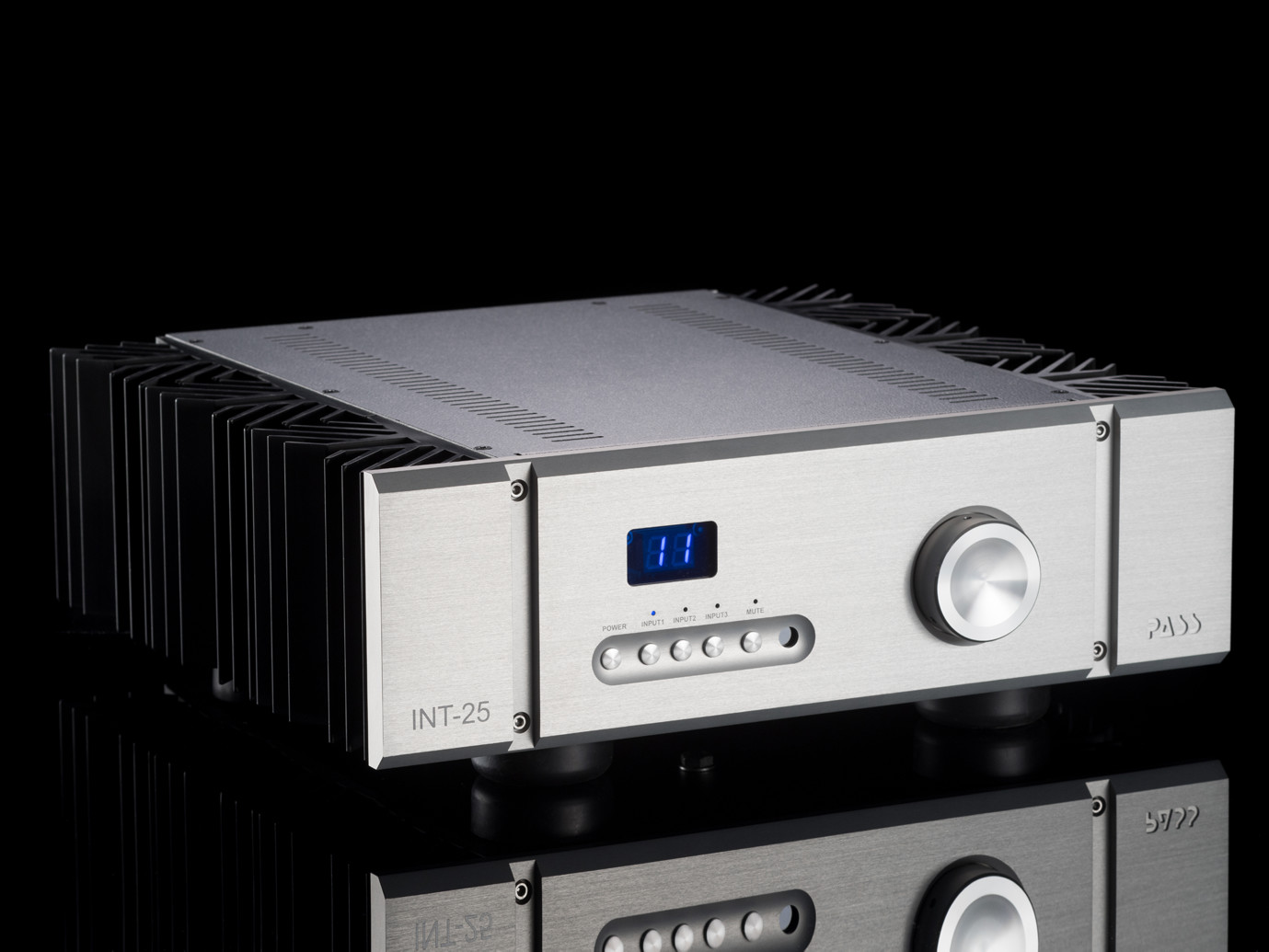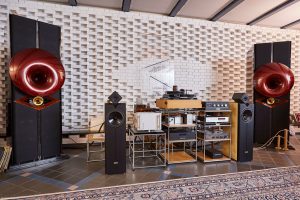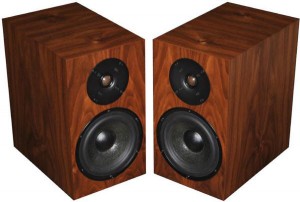The Room
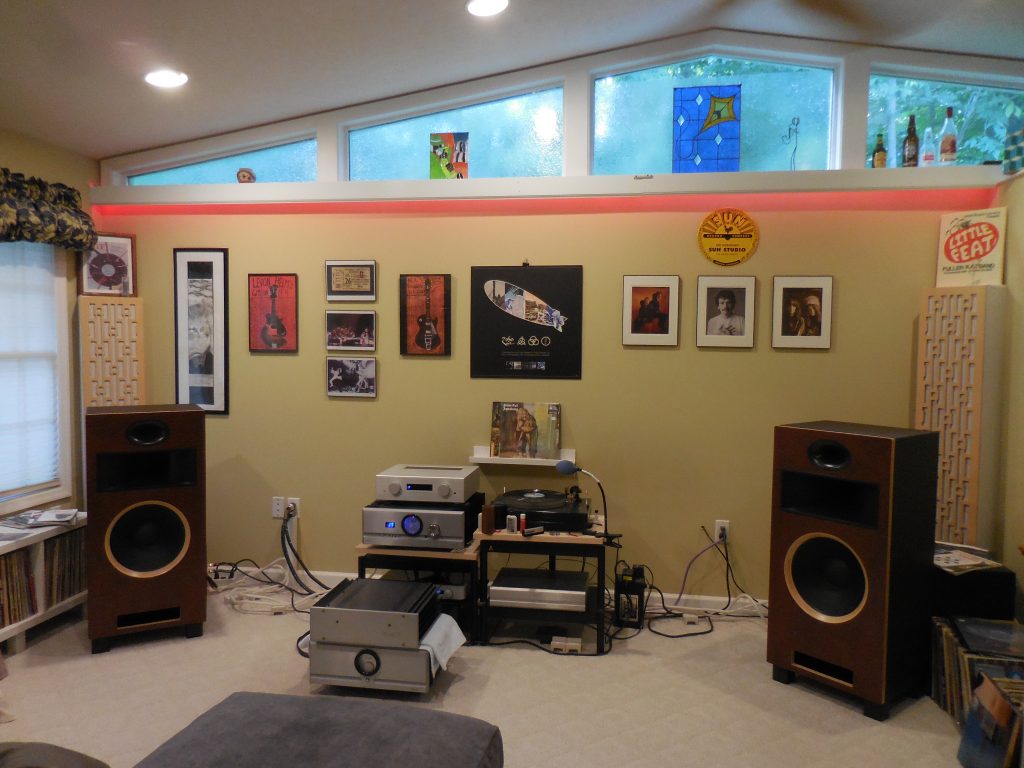
Rivals and a herd of fine SS amplifiers
The Tune Saloon is a complex listening space (click on my name at the top for a more complete description), but the basic listening area is 16' x 12' with speakers set up on the long wall. It is minimally treated with GIK acoustic treatments, and filled with furniture, albums, (and full whiskey bar).
Have Fun!
Volti Audio's tagline is "Have Fun!" Greg Roberts stressed that although the Rivals are serious speakers with an abundance of tuning options, the goal is not to freak out about all the available choices, but to have fun trying them.
As with most speakers, set-up is critical. Greg had them dialed-in within 20 minutes. His preferred setup in my long-wall situated room was fairly close to the corners—no more than a couple feet from the side and back walls. They were toed-in to cross in front of the the listener; a fairly significant angle, perhaps as much as 45 degrees. After a little tape-measure math, both speakers were exactly the same distance from my listening position; 192" to the tip of my nose, and spaced about the same distance between the speakers. Greg continued to dial in the toe angle until the center image snapped into focus. Wow! I could not imagine these speaker disappearing so completely, but they did. Since we listened to the speakers before completing the set up, I was in firm agreement that Greg had nailed the location so I never messed with it after the first day.
What I did play with—early and often—was the adjustable L-pad. Simple, yet elegant; the adjustable crossover is a home run with me. Greg and I both noted a bit of edginess in the upper octaves, but decided to leave the crossover resistors in the factory configuration to allow me to make my own judgement.
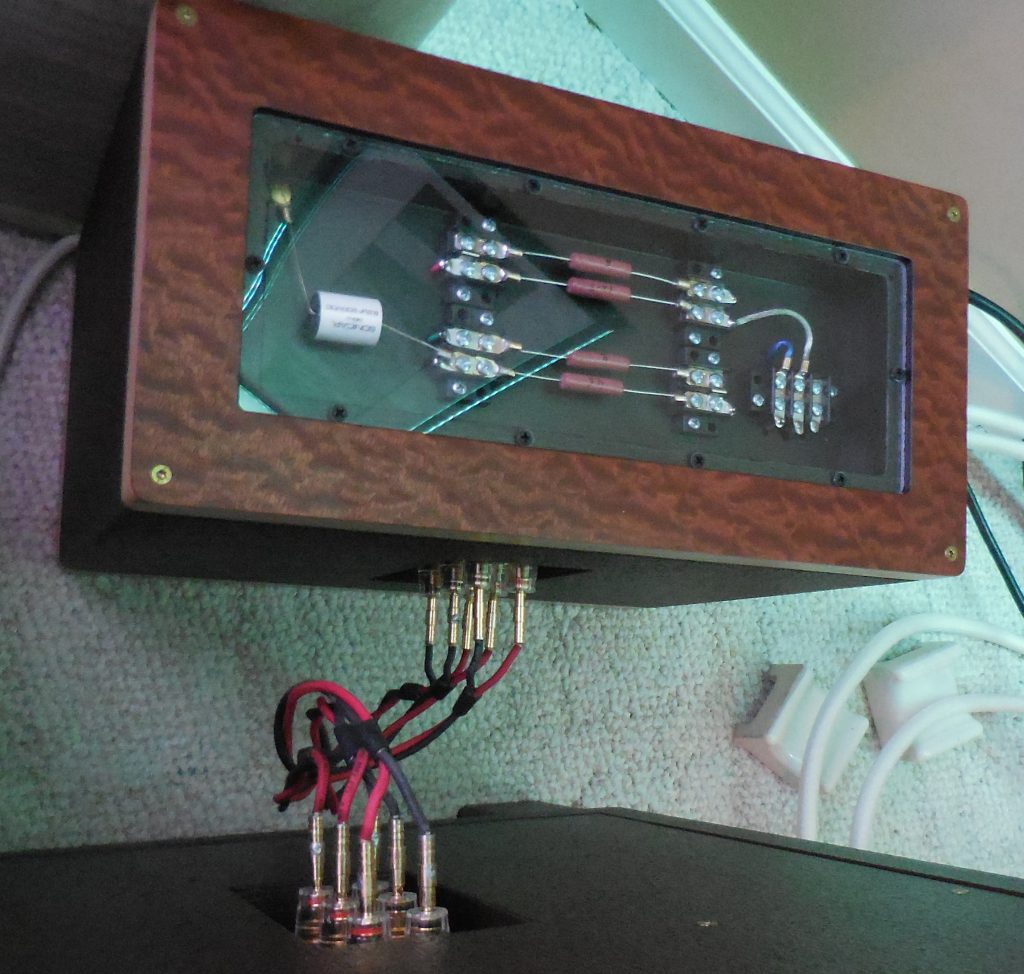
Reflections in the Lexan are not a part of the crossover!
I methodically changed resistors and listened for changes. Over a period of a couple days, I tried many different resistor combinations. I also played with each of the inductor settings. All changes were audible, and it was very cool to be able to change the tonal balance of the speakers in only a few seconds. After much sound-foolery (Having Fun, remember?), I returned to the factory settings for good. However infrequent they may be, I preferred the truthful moments of hot and edgy over softening the exciting response of the Rival.
After about 3 weeks of playing the Rivals three or more hours per day, the speakers seemed to take a leap forward in terms of smoothness and resolution. After this break-in period, the hot treble I'd noticed from time to time was mainly heard on poor recordings.
Descriptions of General Performance
Horns are a rightfully popular choice among audiophiles. Yet many of us have reasons--whether real or imagined—to overlook them. Yes, some horns are huge. Not much can be done about physics, and yet, the Rival is not a huge speaker, its size manageable for many small rooms. Some horns exhibit sonic imperfections. If the Rival did beam, shout, or sound colored, I didn't notice it. What I heard was a combination of unrestrained dynamics, clarity, impact, and passion.
Although Rivals are room friendly, and will likely perform well in a variety of locations, I was happy to have them dialed in to perform their best from the start. The Rivals imaging was exceptional. Instruments and voices pinpointed within the stage, increasing sonic realism. Image height was excellent. My room has not allowed any speaker to manifest an out-of-body experience of depth, Yet the Rivals were the best I've heard.
While not the best space to recreate an illusion of depth, the Tune Saloon is great at showing off the Rivals wide, and dimensional staging. From one wall to the other, there was music with the Rival. And when a recording calls for a right or left instrument or voice, it does indeed come direct from the speaker as a point source, but because the stage extends seamlessly between, as well as beyond the outside of the speakers, acoustic energy heard directly from the drivers becomes a part of the broader stage.
One thing that should be reinforced about the Rival; although they are highly directional, and can indeed disappear when sitting in the sweet-spot, they sound very good off-axis too. On two different occasions, I hosted listening sessions with some non-audiophile, music-loving buddies. I spent a majority of those evenings sitting within a couple feet of the right speaker. The Rival still sounded great. Good stuff.
In the Audiophile Lexicon
Transparency: The Rival is transparent right to the source. Every component change, every musical selection showed off the Rival's clarity and low coloration.
Detail: The Rivals are very detailed. But never so much that I found myself focusing on individual details to the point it detracted from the overall musical event.
Resolution: The Rival is able to unravel the most complex music without congestion. I was quite taken with their ability to separate and layer the music, and it was always easy to follow various melodic lines of instruments and voices.
Coherence: The drivers and crossovers are well integrated, and these ears could not detect crossover points during normal listening. Music is presented with great lucidity, and as such, I never felt I was listening to speakers over music.
Tone: I loved the Rival's tonal balance. Instruments and voices sounded very real to me.
The Frequency Spectrum: The lowest octaves are sensational. Bass is deep,fast, and articulate. The midrange is naturally warm and inviting. Voices are beautifully presented. Treble is extended, and generally silky smooth, with only infrequent moments of recording-dependent stridency. The entire frequency range is treated very well, but my favorite was bass from the 500Hz bass presence range on down; and more specifically, instruments like bass guitar, upright bass, the lower registers of the piano, and drums. These frequencies were clear, powerful, and naturally resonant.
Dynamics: Dang! The Rival won me over with exciting dynamics. Micro-dynamics were excellent, the quick little shifts in volume bringing recorded music alive. But as good as the micro-level is, it was the Rivals ability to quickly swing from quiet musical passages to memorable crescendos that really moved me. This high-wire dynamic act gets better the louder the Rivals are played, so of course I turned them up—a lot. Typically, I do not listen loudly; 80dB peaks, perhaps pushing 85dB when I want to turn back the pages. 90dB plus, required a quick return to listening civility. To save my ears if nothing else. Once I turned the volume down to more pedestrian listening levels, the Rivals were still quite able to produce believable (and fun) dynamics. Rave on Rival!
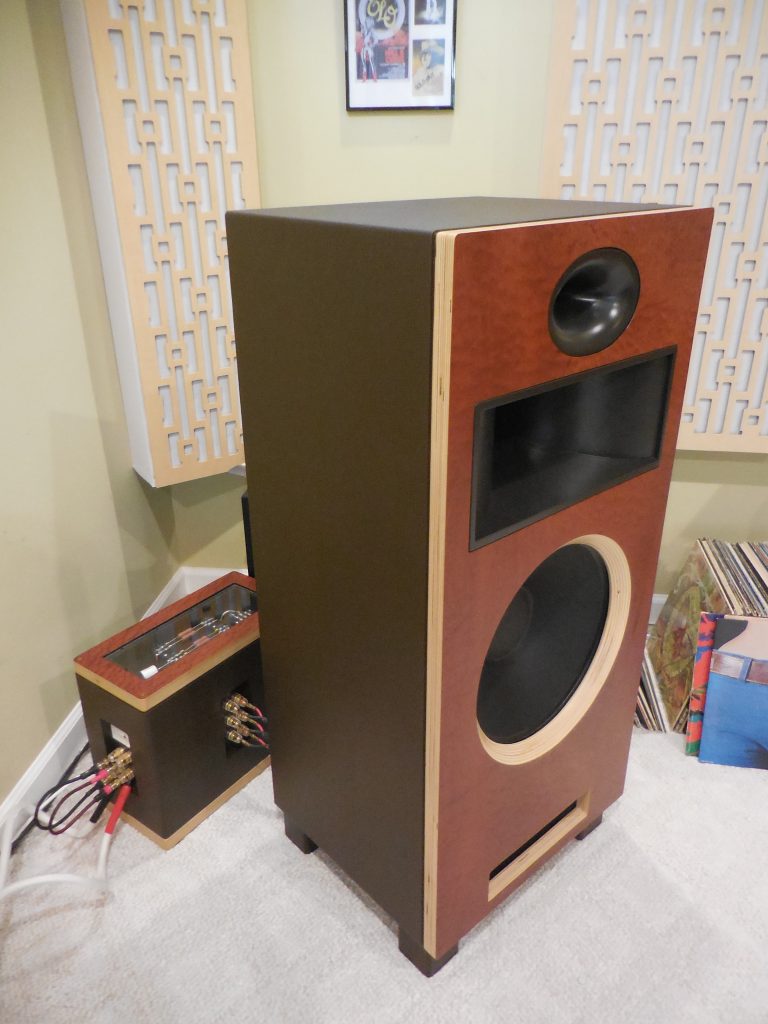
Partners in Power
Prior to hosting the Rivals, I'd only heard Volti speakers driven by Gary Dews' fabulous Border Patrol tube gear; clearly a perfect partner. In lieu of tubes, I had a fleet of solid-state amps: First Watt, Pass Labs, and AVM. Rated at 100 dB Sensitivity and 6 ohm impedance, I found the Rival to be an easy to drive with all of them.
One of the most interesting things about the Volti Rivals is how easily they show differences between amplifiers. More than simply saying the Rivals have no sound of their own, these speakers seemed to behave differently which each type/design of amp I used. The clarity and power of the AVM Evolution A5.2 Integrated (HERE) was pretty amazing, especially at very low listening levels. The superb First Watt F7 (HERE), was an excellent match. While being ever-so-slightly limited in ultimate volume, it softened the Rivals occasional hard edges just a silky hair, providing wonderful tonal shading, and inner resolution. The Pass Labs XA30.8 (HERE) proved to be a nice mix of both the AVM and the F7.
As long as I didn't want to wake the neighbors with Led Zep turned up to eleven, the F7 made the most transparent magic with the Volti's. The more powerful XA30.8 was the most dynamic and meaty, and perhaps the best overall.
Musical Moments
As the last link in the audio chain, speakers are arguably the most important part. I don't really do the audio-review buzzwords all that well. And to be honest, I don't think they can make up for the simple act of listening to music. And that I did.
As you might expect, Rivals love classical music. I listened to the 1812 Overture, The Grand Canyon Suite, Appalachian Spring, The Planets…All were wonderful. The Rival also loves Prog-Rock classics like Alan Parson's "The Voice" from IRobot... And my newly purchased copy of Steven Wilson's remix of Jethro Tull's Aqualung on vinyl got two thumbs up from my friends.
I was rather shocked at how terrific digital recordings sounded. "Savannah Woman" from Tommy Bolin's Teaser was quite a thrill, with a huge, 3D stage, and so close, Bolin felt like he was right right in the room.
The musical tension and power in the song "Beauty" from Chick Corea's 1988 masterpiece Eye of the Beholder CD was fantastic. The entire listening room was engulfed by the performance. Crescendos were incredible, yet there was an exquisite delicacy to Chick's piano during quiet passages.
Ocean Color Scene's "The Riverboat Song" from their 1996 CD release Moseley Shoals revealed the Rival's incredible separation. The first time a guitar lick came zipping out of the flared horn mouth like a laser to my brain, it actually startled me!
On Sarah McLachlan's tune "Elsewhere" from 1993's Fumbling Toward Ecstasy album, I noted excellent tonal contrast. The timbre of the piano was breathtaking.
My 1976 vinyl recording of Passport's Infinity machine, really showed off the Rivals transparency to the source. Even though I clearly hear compression, the Rivals really brought the dynamic interplay between the percussive elements to the forefront. The tone of the piano and sax was especially good.
Near the end of Phoebe Snow's amazing live rendition of "At Last" from 1991's New York Rock and Soul Revue-Live at the Beacon CD, Ms. Snow and the saxophonist hold a note that is so pure it is a moment of sheer musical perfection. The Rival reproduced it so well it gave me chills.
Joe Jackson kicks ass on "I'm the Man" from his 1979 album of the same name. The entire band occupied the imaginary stage between the speakers, and the sensation of "being there" was unmistakable.
Roger Daltrey's song "Times Changed" from his 1992 solo effort Rocks in the Head was a grand show of the dynamic impact and power the Rival is able to display. This is one I couldn't help but turn up way too loud.
The emotional rendition of "Lilac Wine" by Jeff Buckley on his only studio recording, 1994's Grace, showed the Rivals ability to produce a highly dimensional soundfield. Buckley's voice was almost touchable as it floated on sonic air.
You might not believe this one, but the Rival's even made the sterile, reticent sound of Donald Fagen's Kamakiriad sound (almost) alive with emotion. No kidding!
The last complete recording I played through the Rivals prior to their departure was a pristine Mushroom Records Canadian pressing of Heart's masterpiece, Dreamboat Annie. It was a bit on the compressed side, but the entire band came through loud and clear, the music just as wonderful today as it was when I first heard it in 1975. That the Volti Rival could take me back to my formative days while providing such a leap in resolution to a powerful aural memory, is a testament to their musicality.
After the Golden Rush
My favorite way to listen to the Volti Rival was late at night when utility power was best, and my house was quietest. Turn out the lights, and turn up the volume: In my many nights of doing just this—reviewing can be such a hardship—I never once wanted these speakers to make the return trip to Tennessee. Nope. Don't do it, Greg. Don't pick them up...
...I'm Having Fun!
Sadly, the Rivals are now gone. To say I was impressed with this special version of the Volti Rival would be an understatement. Although you might be able to get a sense of what these speakers can do at an audio show, living with them is the only way to truly understand how wonderful they sound. And the Rivals are a speaker I could live with, they made me smile from ear to ear every time I sat down to listen. That's about as good as it gets.
My thanks to Mr. Greg Roberts (who is Volti Audio), for making this review possible.
Volti Audio Rival
Base retail: price per pair $8900.00 USD
Front Veneer $500.00 USD
Premium External Crossover Upgrade $2500.00 USD – includes TWL wiring throughout
Reusable Shipping Crates $300.00 USD
Extra Feet (This pair came with two sets of feet in different styles) $100.00 US
Volti Audio
6100 Nashville Highway
Baxter, TN 38544
207-314-1937
All images by Gary L. Beard and Volti




